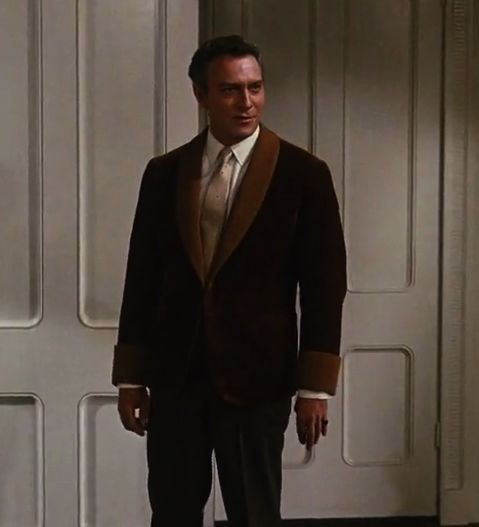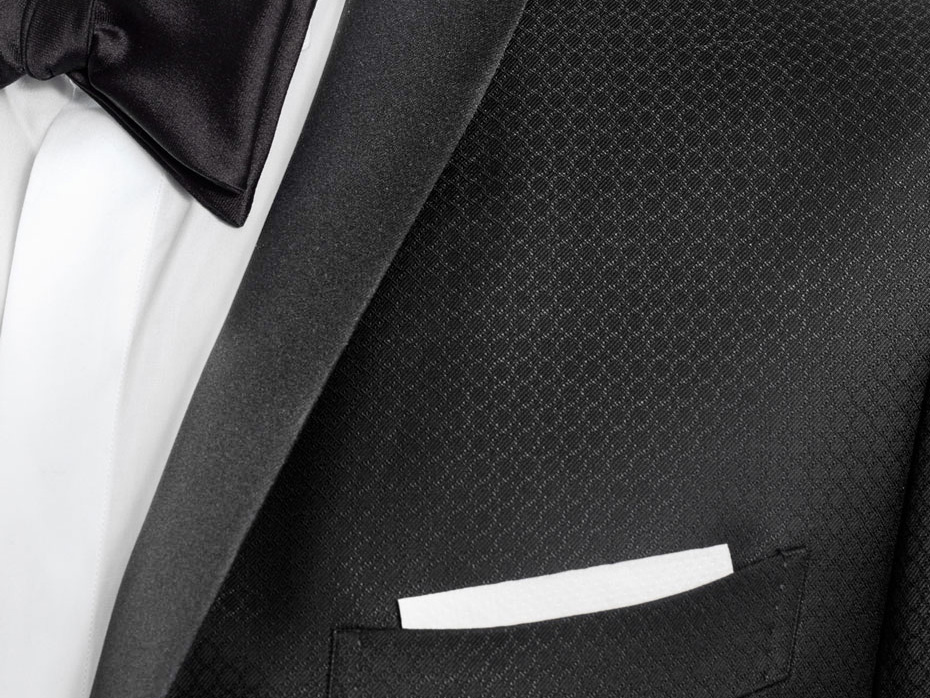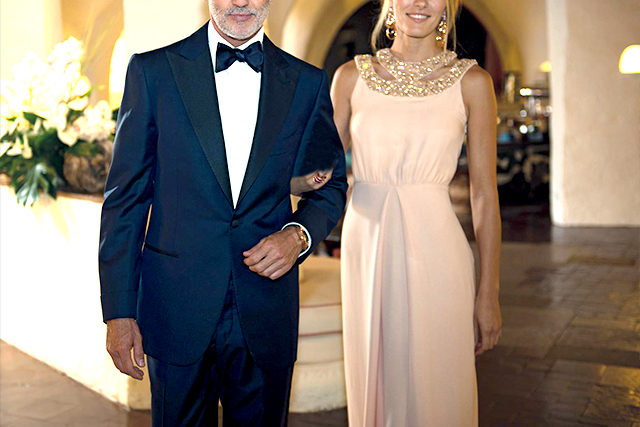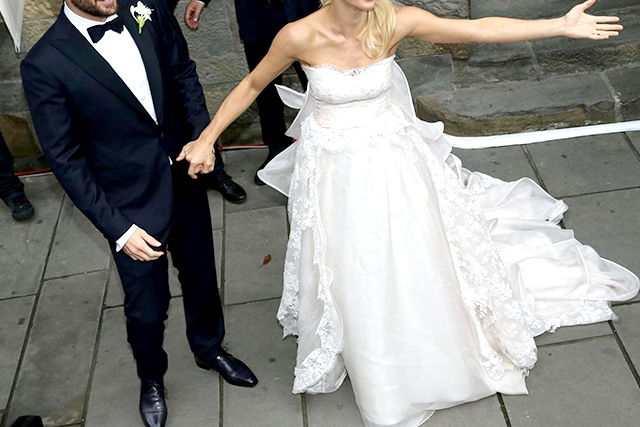Whether it’s a graduation, baptism or wedding, the word “occasion wear” becomes a more significant option. The classic attires, also in the dark and solid colours, are a valid alternative even if they hint of a little informality; instead the tuxedos because of their shape and origin, have always been the ideal choice for the very special occasions.
If we have to reveal just for the for the sake of tradition and a little out of respect for etiquettes, we Italians are not big fans of tuxedos as a wedding suit, but it is also true that weddings are one of the few occasions during the whole year to show off the well polished black-tie look.
Just simply wearing a tuxedo does not automatically assures refinement and elegance, in fact, there are some rules to be followed as to make the black-tie ensemble really impeccable and avoid making obvious mistakes.
Here are our tips on when, where and how to wear a tuxedo and take the leap towards elegance that is worth turning heads.
Menu
Story of the tuxedo: what makes a tux a tux?

To understand the origin of Tuxedo, first we need to dive into the origin of the tailless “smoking jackets”. In England during the 17th century, after dinner the gentlemen might put on a smoking jacket and retreat to a den or smoking room.
In fact, in the beginning the purpose of the jacket ensured that their evening coat would not be burned by ashes nor absorb the smell of tobacco which the women found distasteful.
It was used as an elegant evening attire, however, because of the Prince of Wales Edward VII who in 1865 commissioned to his tailor Henry Poole to create a short blue evening jacket, to be used for informal evenings in his country estate of Sandringham.
From that project was born the ancestor of what everyone including we Italians call today as tuxedos, the English “dinner jacket” (or dinner suit) and the Americans “tuxedo” (because of its original word spread starting from the homonymous village of Tuxedo Park).
When to wear a tuxedo
Since its origins, tuxedo has always been considered the evening outfit par excellence. The original purpose of this elegant clothing was to replace the suit worn all day, allowing men to leave behind the dirt and smell of a day spent on horseback.
The choice of wearing a tuxedo epitomize the desire – among people of high social inclination – to be fresh, clean and as attractive as possible when meeting on evening social events and attending high spirits affairs. This tradition was maintained also with the beginning of the use of the automobile, when there was no practical justification.
Before the Second World War, tuxedos and tails were still considered the only appropriate clothing for all the elegant social evenings. However, after the war, the traditional suit, or the work suit, began to be accepted more on informal evening and daytime occasions, and so the use of the tuxedo was limited to just formal evening gatherings only.
Never before evening..?
Regardless of how evening dress code is defined, tuxedos should never be worn in daytime affairs. This rule can be really is difficult to follow during the summer, particularly in regions with ample of sun, etiquette experts were therefore forced to develop more practical and less vague guidelines.
The most common practice is to define the evening in chronological order and discourage wearing tuxedos in public before 6 pm. On the other hand, globally, allows greater flexibility based on the latitudes of the Earth and states that in the evening starts at 6 pm or when darkness falls, whichever of the two conditions is met first.
In either case, unless you work as a waiter, the only excuse to wear a tuxedo during the day is if you are going to an evening event or if you have to attend some certain diplomatic functions.
…even before evening
The custom of reserving the tuxedo for formal events held after 18.00 is still widely followed in Great Britain, a country where this tradition has been maintained and where the use of the morning coat, a daytime option of the tuxedo, is still present.
Instead, in the United States (and in many other countries), the custom initiated from the Second World War, daytime formal clothes like the morning coat have almost completely disappeared; in their absence, most Americans have started to consider the tuxedo as a “formal attire” for all uses, and therefore they wear tuxedo also during the day.
As a result, the proper evening use of the tuxedo has become a habit generally limited to a privileged people that attend the “black tie” events quite often to consider the tuxedo as an integral part of a man’s wardrobe, rather than as a garment to rent out rarely in life.
At what age can you wear tuxedo
Evening suits have been designed for “adult” occasions and for this reason the tuxedo is considered traditionally inappropriate for toddlers or young boys.
As a general rule, boys should not wear tuxedos before the age of fifteen and tails should not be older than 18. These are rules that date back to the ’60s, but these guidelines remain perfectly relevant even today when one considers that this is the age when young people begin to replace their clothes with mature clothing.
Is there an easier way to define at what age you can wear a tuxedo? Maybe yes. Everything can be reduced to a simple thumb rule: if a boy is too young to be able to tie a bow tie, then he is too young even to wear a tuxedo.
Where would it be appropriate to wear it
Today, most formal events requiring tuxes explicitly states the same on the invitation or in other forms of guest instructions, usually indicating that it would be a “black tie” dress code.
However, there are some occasions where the use of the tuxedo is implied and awaited, or at least warmly recommended.
Theatre and Opera
Opera and theatre are traditionally considered the most prestigious of all art forms and as a result, have always required viewers to dress the most formal style of clothing.
During special events like the first of the ballets or the opening evenings of important theatrical shows, it is still common in many cities to see the best seats occupied by fans dressed in tuxedos.
Events and private parties
Nowadays, the use of tuxedos has largely taken hold in many private events (such as gala dinners) which were once reserved for the more formal tailcoat or frac.
As mentioned previously, however, most of the formal private events that require the tuxedo who explicitly declare it with the words “black tie”.
In the absence of these signs, thanks to the progressive relaxation of the etiquette linked to formal wear, the use of a classic suit instead of a tuxedo is still accepted.
Debut in society
The debutante ball or deb – is a formal event that involves the formal introduction of young women as she has reached maturity typically 17 or 18 – into society as a new adult.
Although this occasion is limited to a very young and restricted band of society, the dress code for men attending this dance usually requires a tuxedo. Though this rule is not always respected by young people who often opt for dresses that are formally distant from the classic black-tie look.
Wedding
If you are invited to a late afternoon wedding, which takes place in a cathedral and is followed by an elaborate reception, it is likely that the bride and groom may have decided to opt for a black-tie dress code.
Considering that the official etiquette requires to wear a tuxedo only in the evening, the use of this type of dress is recommended only if the wedding takes place after 18 (or after sunset).
Having said that it is good to remember again how the use of the tuxedo even for weddings celebrated during the day has been widely cleared in North America; if you are invited to a wedding in the United States that will take place during the day, wearing a tuxedo could, therefore, be admitted.
Prom
Getting dressed for calls for some rules i.e just keep it classic, keep it timeless; and keep it tasteful. Once you have decided to wear a tux to prom you can not lack in details. We advise getting a custom-made tuxedo over renting one, the custom fit just enhances your personality like nothing else.
Prom is one of those occasions where you take all those important pictures and look back at them after years just to relive the magical night, you will thank yourself that you went for a timeless look that even after all those years seem very enchanting.
How to wear a tuxedo
If the invitation to a wedding or a premiere at the theatre specifically require a “black tie” attire you have no other alternative, you must wear a tuxedo accompanied by the classic black silk bow tie.
But what are the other details to seek when wearing a tuxedo? Here are some rules to choose the right dress and match it with the right accessories.
The jacket? Single-breasted and with adaptable lapels
The tuxedo jacket must be strictly single-breasted without back slits and with a single button front fastening. Lapels? Exclusively peaked or shawl.
The jackets, two or three buttons, the ones you usually wear in the office, instead are not formal enough; better to reserve them for other occasions.
Another detail of the jacket to be kept in mind is the pockets: it is better to opt for welt pockets, they are more formal than the flap pockets.
The colour: blue, black or ivory
Choose the colour of your tuxedo between the classic black or the more modern blue. With black are always playing a safe game; blue is a more modern choice for the more daring gentlemen, although you should evaluate the colours according to the context of the event.
The choice of the ivory-coloured jacket is more appropriate for the summer season.
The white tuxedo version, made famous by Hollywood actors, is only allowed for en plein air events.
Wear a shirt with a wingtip collar
The shirt of a black-tie look must be strictly white and can be personalized with the appropriate tuxedo collar. It is also called wingtip collar which is characterized by the typical front wings and is designed to be worn with the bow tie.
A customisation not to be forgotten is that of the cuffs that will have to be double cuffs (turned up on themselves) and will have to provide the buttonhole in which to insert the cufflinks.
Black bow tie in silk
The bow tie? Black in silk. The white bow tie only compliments the tailcoat. At least once, leave the tie in the closet.
Trousers with braces
In the choice of trousers, wearing trousers that include the application of braces, the belts, as practical, are not suitable for a look as formal as black tie.
Choose black or white braces in fabric, rather than in leather, or in any case they should be matching the colour of the tuxedo.
Finally, avoid trousers with lapels or pleats, once again not formal enough for the occasion.
Choose appropriate shoes and socks
Wear shiny black or matte laced shoes. Even embroidered slippers can suit you fine in this case, just do not wear shoes that contains too many details.
The socks must be black and up to the knee. No exceptions will do any justice to the look.
Details
Wear the vest if the jacket is fitted with pointed (peaked) lapels and the satin cummerbund with shawl lapels. Customise the tuxedo with satin or twill details like the lapels and the iconic side band of the trousers.
Finally, wear a white pocket square in linen or cotton. Some men love to experiment in the look with red or burgundy silk pocket square, but a little creativity is what makes each look sharp but unique.








Thanks for pointing out that when wearing a tux it is better to opt for welt pockets, they are more formal than the flap pockets. My husband is thinking about renting a tux for a wedding that we are going to because the invitation says black tie. I think it would be smart to go in and try some tuxes on and when we do I’l have to remember to look for welt pockets.
That’s interesting that if it’s after sunset for a wedding it’s a good idea to wear a tux. Recently, my cousin announced he’s getting married and I don’t have a lot of formal clothes. I’ll have to look into getting a custom tuxedo.
I have had custom and off the rack tuxedos- own two now: a custom black notch collar and a midnight blue shawl collar off the rack from CT. Custom is great, not just for sizing, but because you can customize pockets, trims, buttons, etc. Both came with suspender buttons. Can’t believe that some OTR companies are now selling so-called tuxedo pants with belt loops.
We can’t agree more with you!